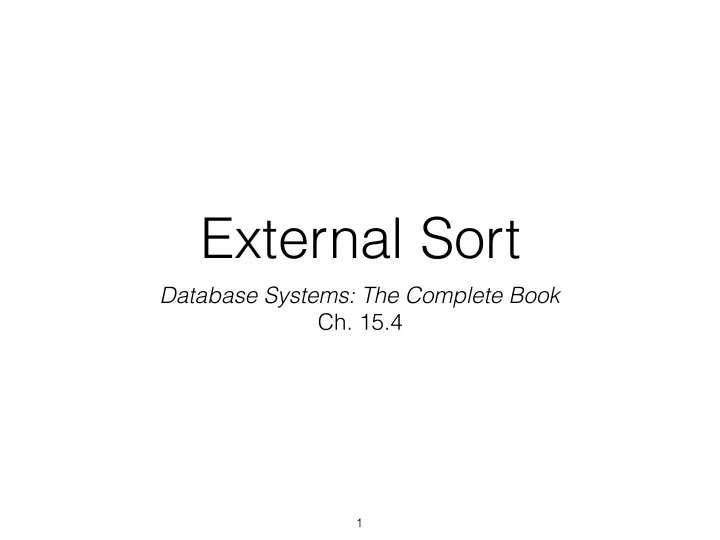

External Sort Database Systems: The Complete Book Ch. 15.4 1
Operator Memory Needed Project O(1) Select O(1) Bag Union O(1) Join O(1) or O( |R|+|S| ) Group O( |G| ) Distinct O( |R| ) Sort O( |R| ) 2
You can get away with almost no disk-based algorithms… … as long as you have external sort. 3
2-Way Sort Pass 1 Load a Page Sort the Page Flush the Page image credit: openclipart.org 4
2-Way Sort Pass 2 and beyond Read from 2 (sorted) buffers of size K Merge Sort into 1 buffer of size 2K Repeat (how many times?) 5
2-Way Sort 3,4 6,2 9,4 8,7 5,6 3,1 2 3,4 2,6 4,9 7,8 5,6 1,3 2 2,3 4,7 1,3 4,6 8,9 5,6 2 2,3 4,4 1,2 6,7 3,5 8,9 6 1,2 2,3 3,4 4,5 6,6 7,8 9 6
Generalized External Sort How can we use N buffer frames? For Pass 1? Sort Bigger Initial Buffers For Pass 2 onwards? Merge-sort Multiple Streams How many passes do we make over the full data? For data of size N, a K-way sort requires passes How many IOs do we use? 2 · # pages · # passes 7
Pass 1 is memory-limited If we have N pages of memory, can we create more than N pages of sorted data? 8
Replacement Sort General idea: Create “runs” of sorted data • Keep a very large “working set” of data. • Keep appending data in ascending order to an output buffer. • As you flush sorted data to the output, keep loading new • tuples into the working set. If you get new tuples useful for the current buffer, great! • Otherwise, they’ll go into the next run • When you run out of valid tuples to append, start a new run! • 9
Replacement Sort Repeat until k is Step 3 : Insert a tuple bigger than all values Step 2 : Append the value Step 0 : k is the last value Step 1 : Find the lowest from the input buffer Input Buffer in the working set to the output buffer value in the working set that was appended to the 2 and re-sort the 12 and update k greater than k output buffer 8 working set Finish the “run” 10 and start a new one k=8 k=5 … Working Set 5 3 Output Buffer 10
Replacement Sort E[k] = avg(k) On average, half of the tuples you read in will be useful for the current stream. If you have N pages of memory, how many pages of sorted data will you make? 11
How do we use sorted data to implement other memory-bound operators? 12
Joins 13
Implementing: Joins Solution 3 (Sort-Merge Join) Keep iterating on the set with the lowest value. When you hit two that match, emit, then iterate both 1 1 1 2 4 3 5 5 5 6 Done! A B 14
Distinct 15
Sort-By Distinct 1 2 4 5 1 6 3 5 16
Sort-By Distinct 1 1 2 3 4 5 5 6 1 2 3 4 5 6 17
Group-By 18
Sort-By Grouping 1,1 2,2 4,3 5,4 1,5 6,7 3,8 5,9 19
Sort-By Grouping 1,1 1,5 2,2 3,8 4,3 5,4 5,9 6,7 6 2 8 3 13 7 20
Recommend
More recommend